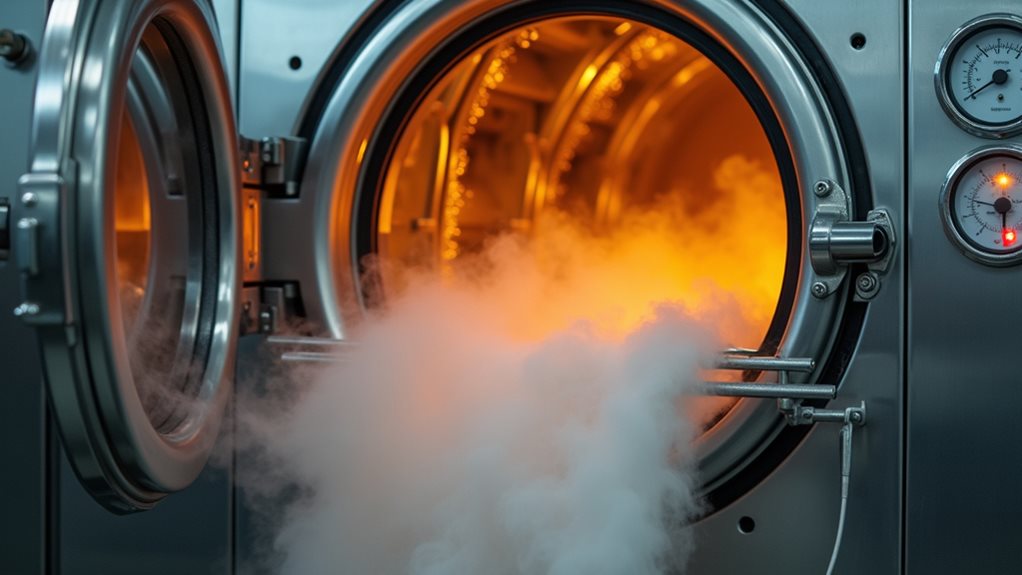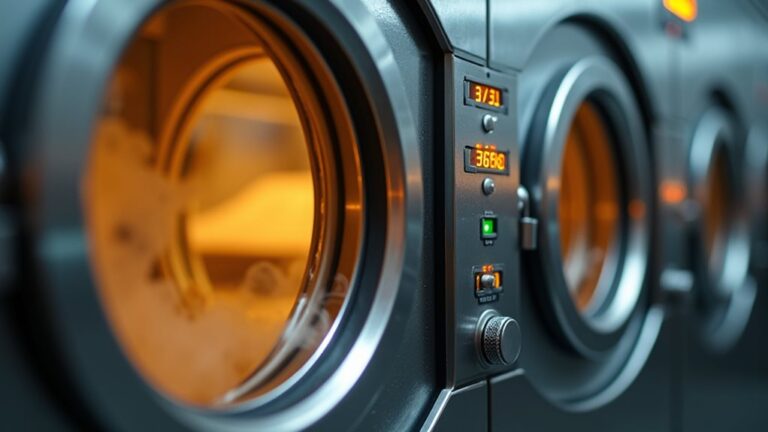You’ll experience dry cleaning temperatures ranging from a comfortable 86°F during the cleaning cycle to an intense 145°F in the drying phase, though delicate fabrics like silk and lace stay safely below 140°F while synthetics can handle up to 180°F. What’s truly eye-opening is that dry cleaning workers endure indoor temperatures exceeding 130°F for eight-hour shifts, creating sauna-like conditions that require frequent clothing changes and constant hydration. There’s so much more happening behind those steamy machines.
Temperature Ranges in Different Dry Cleaning Stages
Three distinct temperature zones work together in dry cleaning to protect your clothes while getting them spotless, and understanding these stages helped me realize why my silk blouse came back looking brand new instead of shrunken like that time I accidentally threw it in my home washer 😅.
The dry cleaning process starts with a cool cleaning cycle at 30°C, where your garments are inspected and gently bathed in cleaning solvent that won’t damage delicate fibers.
Next comes the rinse stage using fresh, unheated solvent for thorough stain removal.
Finally, the drying cycle reaches 60-63°C, tumbling your clothes in warm air to restore their shape and remove moisture, creating that crisp, professional finish we all love.
These controlled temperatures allow chemical solvents like perchloroethylene or eco-friendly alternatives to effectively dissolve oils and greases that water-based washing cannot remove.
Heat Requirements for Various Fabric Types

When you’re standing at the dry cleaner’s counter, wondering if your favorite silk blouse will survive the process, you need to understand that different fabrics have wildly different heat tolerances.
Honestly, I learned this the hard way after shrinking my grandmother’s vintage wool coat 😅. Your delicate fabrics like silk, lace, and cashmere require much gentler temperatures, typically staying below 140°F, while your trusty polyester work shirts can handle considerably more heat without breaking a sweat.
The key is recognizing that natural fibers like cotton and wool fall somewhere in the middle of this temperature spectrum, needing careful attention to prevent the kind of disasters that’ll have you explaining to your spouse why their expensive sweater now fits your toddler.
Understanding these temperature requirements becomes even more critical when you consider that chemical solvents like perchloroethylene work differently than water-based cleaning methods and require precise heat control to effectively remove stains without damaging your garments.
Delicate Fabric Temperature Limits
Understanding fabric temperature limits feels like learning to cook for someone you love—you want to get it just right without causing any damage, and trust me, I’ve seen enough shrunk sweaters to know the heartbreak is real! 😅
Each fabric type has its own personality when it comes to heat tolerance, much like how some people thrive in a sauna while others wilt at the first sign of warmth.
When you’re dealing with delicate fabrics like silk and rayon, temperature limits become absolutely critical during cleaning processes.
These precious materials can’t handle anything above 160°F without suffering permanent damage. I learned this lesson the hard way with my grandmother’s vintage silk blouse—one careless moment with excessive heat, and what was once elegant became a wrinkled mess that no amount of wishful thinking could repair.
Since dry cleaning uses chemical solvents rather than water-based methods, it’s particularly well-suited for these temperature-sensitive fabrics that might be damaged by traditional hot water washing.
Synthetic Material Heat Tolerance
Although synthetic fabrics might seem like the superheroes of the textile world—tough, durable, and seemingly indestructible—they each have their own kryptonite when it comes to heat tolerance, and figuring out these limits has saved me from countless wardrobe disasters over the years.
Most synthetic materials like polyester, nylon, and acrylic can handle temperatures up to 180°F without breaking a sweat, making them perfect candidates for the dry cleaning process.
However, I’ve learned the hard way that acetate starts getting moody above 140°F, while spandex and elastane throw tantrums at anything over 130°F.
The good news? Professional dry cleaners know these quirks and use gentle rinse cycles at 30°C to keep your synthetics happy.
While temperature control is crucial for fabric care, it’s equally important to consider that traditional dry cleaning processes use toxic chemical solvents like perchloroethylene, which can pose health risks to both workers and customers through exposure to carcinogenic vapors.
Natural Fiber Processing Temperatures
Since natural fibers come from living sources like plants and animals, they’ve retained some of their original sensitivity to heat, which means I’ve had to learn their individual comfort zones the same way you’d learn a friend’s quirks and preferences.
Your wool sweater, for instance, needs temperatures below 86°F during cleaning, while that standard dry cleaning machine typically runs its drying cycle at a toasty 140-145°F – quite the mismatch! 😅
I’ve watched too many beautiful silk blouses shrink because their thermal stability wasn’t respected.
Natural fibers like linen and cotton require gentler approaches, often needing specialized low-temperature processes that honor their delicate nature rather than forcing them through high-heat cycles designed for synthetic materials.
This careful temperature control is why chemical solvents used in dry cleaning are so effective at cleaning these delicate fabrics without the damaging effects of water and high heat that would cause irreversible shrinkage or texture changes.
Solvent Temperature Management During the Cleaning Process
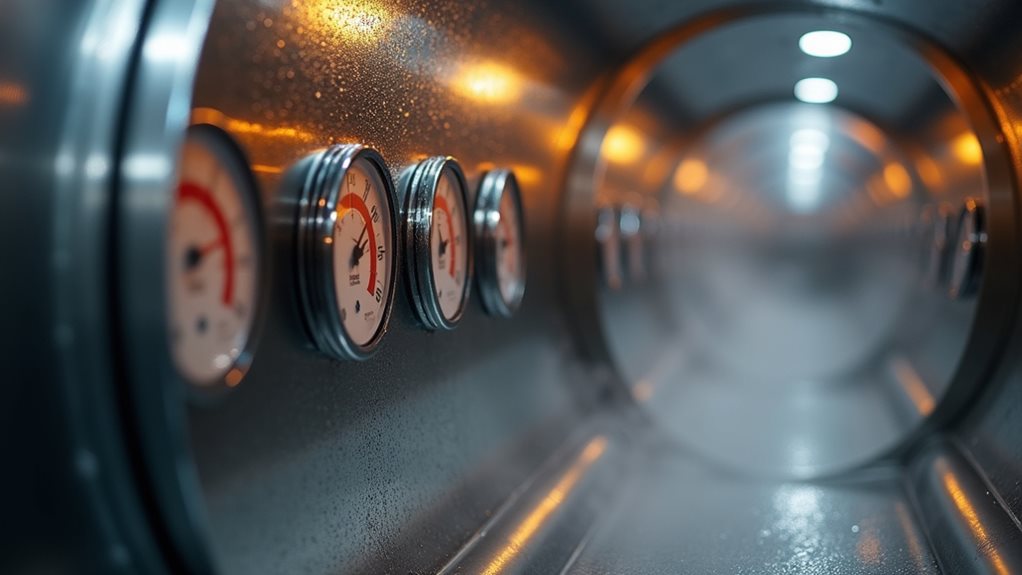
When I first started working at my uncle’s dry cleaning shop during high school summers, I was amazed to discover that the solvents we used barely got warmer than a lukewarm bath, hovering around 30°C or 86°F throughout the entire cleaning cycle.
You’d think hotter would mean cleaner, right? 😅 But here’s what I learned: gentle solvent temperature actually protects your garments while still dissolving stubborn stains effectively.
The magic happens during the rinse cycle, where freshly distilled solvent at these controlled temperatures maintains fabric integrity without causing color bleeding or distortion.
Think of it like washing your face with warm water instead of scalding hot—sometimes gentle is more powerful than aggressive.
This careful temperature control is especially crucial when cleaning delicate fabrics like silk and wool, which require the specialized care that dry cleaning provides over traditional water-based washing methods.
Pressing and Finishing Temperature Guidelines
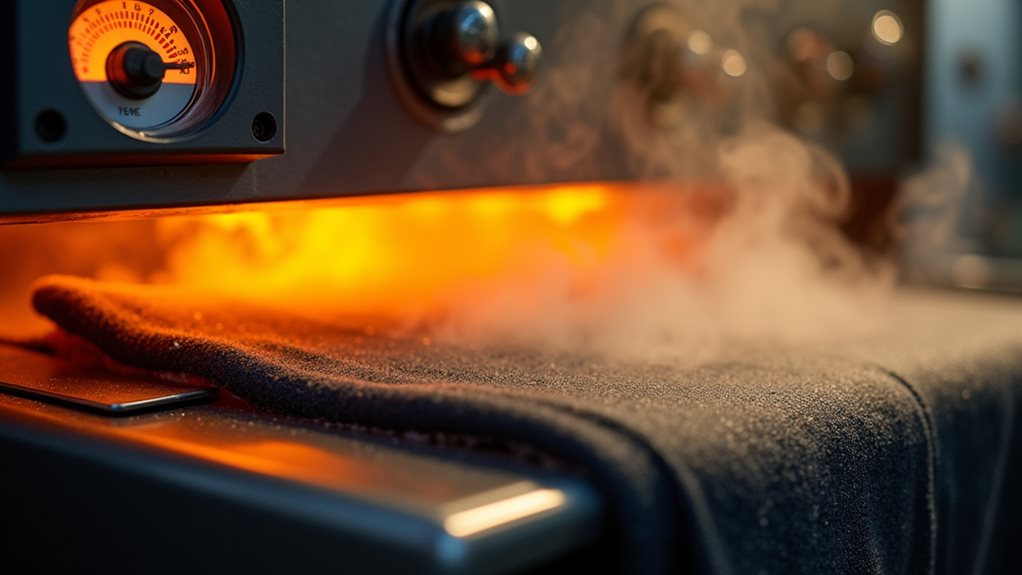
After the gentle solvent bath works its magic, your garments move to what I consider the most vital stage of dry cleaning—the pressing and finishing process, where precise temperature control transforms wrinkled fabric into crisp perfection.
You’ll find that pressing temperatures typically hover between 140°F to 160°F, which I’ve learned through years of experience is the sweet spot for removing stubborn wrinkles without harming delicate fabrics like your favorite silk blouse.
The finishing stage often involves steam at 212°F, which sounds scary but works beautifully when controlled properly.
Quality control becomes critical here—anything above 180°F spells disaster for sensitive materials, and trust me, I’ve seen too many ruined garments from careless operators who ignored fabric care labels.
This careful temperature management is especially crucial for garments with special finishes that could be permanently damaged by excessive heat exposure.
Working Conditions and Heat Exposure in Dry Cleaning Facilities
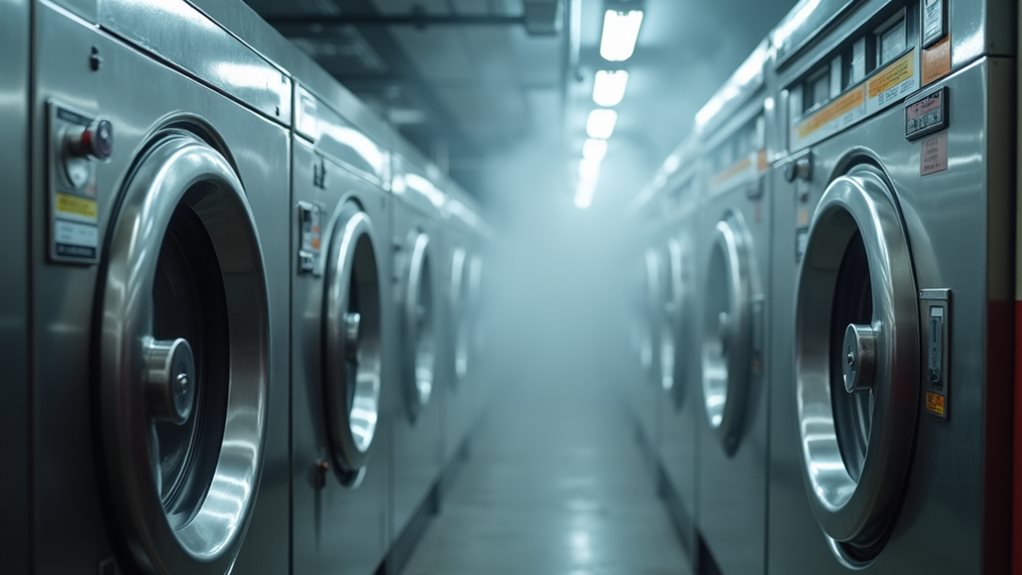
While most people worry about whether their silk shirts will survive the dry cleaning process, what they don’t realize is that the real heroes—the workers behind those spotless garments—are battling indoor temperatures that regularly climb past 130°F, creating what I can only describe as a sauna where people actually have to work productively for eight hours straight.
These employees face brutal heat exposure daily, standing over steaming machines that turn their workplace into an endurance test. The working conditions force them to change clothes multiple times per shift, constantly battling dehydration with Gatorade and strategically placed fans.
It’s honestly heartbreaking watching these dedicated workers push through such physically demanding environments just to deliver our perfectly pressed clothes.
Safety Considerations for High-Temperature Operations
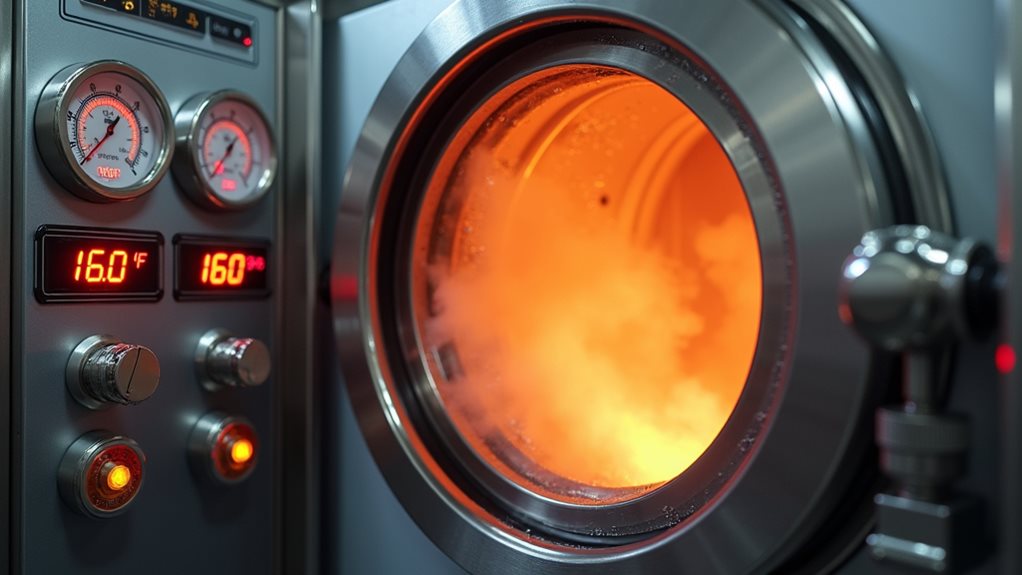
These extreme temperatures I’ve been describing aren’t just uncomfortable—they’re genuinely dangerous, and I’ve seen too many dry cleaning operations that treat worker safety like an afterthought instead of the life-or-death issue it actually is.
When you’re dealing with heat stress in environments exceeding 130°F, you can’t mess around with inadequate worker safety protocols.
Here’s what proper temperature regulation should include:
- Industrial ventilation systems that actually move air instead of just circulating hot, stagnant fumes around the workspace
- Mandatory cooling breaks every hour, not when someone’s already dizzy and nauseous from overheating
- Emergency protocols for heat-related illnesses, because trust me, heat exhaustion hits faster than you’d expect
Some smart businesses temporarily close during extreme heat events—that’s responsible leadership, not weakness.
Beyond temperature concerns, proper ventilation systems also help minimize exposure to chemical solvents like perchloroethylene that are commonly used in traditional dry cleaning processes.

